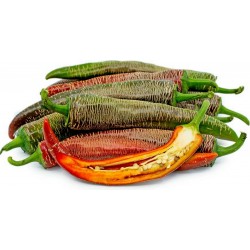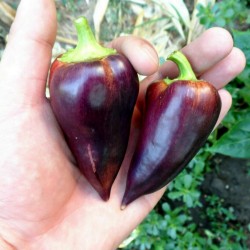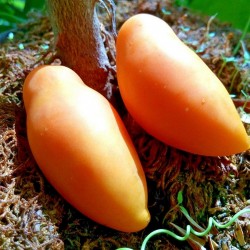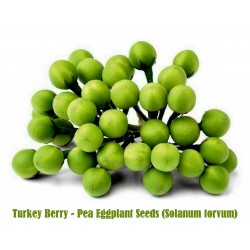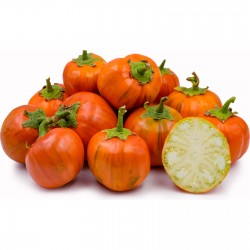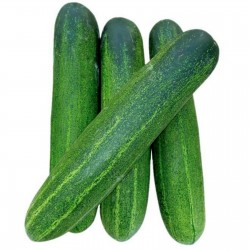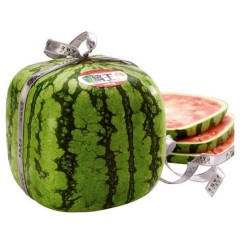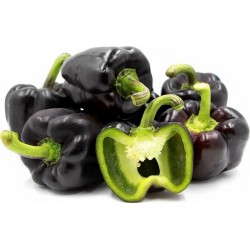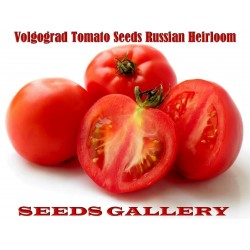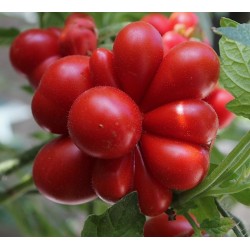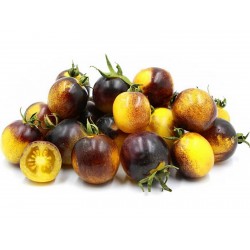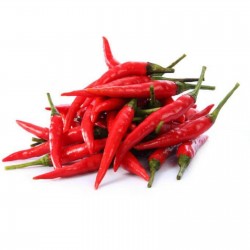Seeds Gallery Com,
5/
5
<h2><strong>Turkey Berry - Pea Eggplant Seeds (Solanum torvum)</strong></h2>
<h2 style="font-family: 'Helvetica Neue', Helvetica, Arial, sans-serif; color: #333333;"><span style="color: #ff0000;"><strong>Price for Package of 5 оr 10 seeds.</strong></span></h2>
<p>Solanum torvum is a bushy, erect and spiny perennial plant used horticulturally as a rootstock for eggplant. Grafted plants are very vigorous and tolerate diseases affecting the root system, thus allowing the crop to continue for a second year.</p>
<p>It is also known as turkey berry, prickly nightshade, shoo-shoo bush, wild eggplant, pea eggplant, pea aubergine, susumber ( Jamaica), boo, terongan, tekokak, berenjena cimarrona, berenjena de gallina, berenjena silvestre, tabacón, pendejera, tomatillo, bâtard balengène, zamorette, friega-platos, kudanekayi (Kannada: ಕುದನೆಕಾಯಿ), sundaikkai (Tamil: சுண்டைக்காய்),[3] (Malayalam: ചുണ്ട ), thibbatu (Sinhala), makhuea phuang (Thai: มะเขือพวง), suzume nasu (Japan: 雀茄子), jurubeba (Brazilian Portuguese), and many other names (Howard 1989, Little and others 1974, Pacific Island Ecosystems at Risk 2001).</p>
<p>The plant is usually 2 or 3 m in height and 2 cm in basal diameter, but may reach 5m in height and 8 cm in basal diameter. The shrub usually has a single stem at ground level, but it may branch on the lower stem. The stem bark is gray and nearly smooth with raised lenticels. The inner bark has a green layer over an ivory color (Little and others 1974). The plants examined by the author, growing on firm soil, had weak taproots and well-developed laterals. The roots are white. Foliage is confined to the growing twigs.</p>
<p>The twigs are gray-green and covered with star-shaped hairs. The spines are short and slightly curved and vary from thick throughout the plant, including the leaf midrib, to entirely absent. The leaves are opposite or one per node, broadly ovate with the border entire or deeply lobed. The petioles are 1 to 6 cm long and the blades are 7 to 23 by 5 to 18 cm and covered with short hairs. The flowers are white, tubular with 5 pointed lobes, and grouped in corymbiform cymes. They are shed soon after opening.</p>
<p>The fruits are berries that grow in clusters of tiny green spheres (ca. 1 cm in diameter) that look like green peas. They become yellow when fully ripe. They are thin-fleshed and contain numerous flat, round, brown seeds (Howard 1989, Liogier 1995, Little and others 1974).</p>
<p><strong>Range</strong></p>
<p>Turkey berry apparently is native from Florida and southern Alabama through the West Indies and from Mexico through Central America and South America through Brazil (Little and others 1974). Because of its rapid spread as a weed in disturbed lands, it is difficult to tell which populations are native and which are introduced. Turkey berry has been introduced and naturalized throughout tropical Africa, Asia, Australia, and the Pacific Islands including Hawaii, Guam, and American Samoa (Pacific Island Ecosystems at Risk 2001). In Jamaica this berry is called susumba, or gully beans, and is usually cooked in a dish along with saltfish and ackee. It is believed to be full of iron (it does have a strong iron like taste when eaten) and is consumed when one is low in iron.</p>
<p><strong>Ecology</strong></p>
<p>In Puerto Rico, turkey berry grows in upland sites that receive from about 1000 to 4000 mm of annual precipitation. It also grows in riparian zones in drier areas. Turkey berry grows on all types of moist, fertile soil at elevations from near sea level to almost 1,000 m in Puerto Rico (Little and others 1974) and 2,000 m in Papua New Guinea (Pacific Island Ecosystems at Risk 2001). Given an equal start after disturbance, turkey berry quickly overtops most herbs, grasses, and other shrubs. It grows best in full sunlight and does well in light shade or shade for part of the day, but cannot survive under a closed forest canopy. Turkey berry single plants, groups, and thickets are most frequently seen on roadsides, vacant lots, brushy pastures, recently abandoned farmland, landslides, and river banks.</p>
<p><strong>Reproduction</strong></p>
<p>Flowering and fruiting is continuous after the shrubs reach about 1 to 1.5 m in height. Ripe fruits collected in Puerto Rico averaged 1.308 + 0.052 g. Air dry seeds from these fruits weighed an average of 0.00935 g or 1,070,000 seeds/kg. These seeds were sown on commercial potting mix and 60 percent germinated between 13 and 106 days following sowing. The seedlings are common in recently disturbed ground. Frugivorous birds eat the fruits and spread the seeds (Pacific Island Ecosystems at Risk 2001). Turkey berry can be propagated vegetatively by placing branch cuttings, with or without leaves, in a mist chamber for one month (Badola and others 1993).</p>
<p><strong>Growth and management</strong></p>
<p>Turkey berry grows about 0.75 to 1.5 m in height per year. The species is not long-lived; most plants live about 2 years. Physical control of the shrub may be done by grubbing out the plants; lopping will not kill them. They can be killed by translocated herbicides applied to the leaves or the cut stumps (Pacific Island Ecosystems at Risk 2001).</p>
<p><strong>Cuisine</strong></p>
<p>The green fresh fruits are edible and used in Thai cuisine, as an ingredient in certain Thai curries or raw in certain Thai chili pastes (nam phrik).[4][5] They are also used in Lao cuisine (Royal Horticultural Society 2001) and Jamaican cuisine.[6] The fruits are incorporated into soups and sauces in the Côte d'Ivoire (Herzog and Gautier-Béguin 2001).</p>
<p>In Tamil Nadu, India, the fruit is consumed directly, or as cooked food like Sundaikkai Sambar, Sundaikkai Poriyal, Sundaikkai Aviyal & Sundaikkai Pulikulambu. After soaking in curd and drying, the final product is fried in oil as Sundaikkai vattral (available in all Tamil Nadu supermarkets), it is famous all around in Tamil Nadu. In siddha medicine one of the traditional systems of India Sundaivattral Choornam is used to improve digestion.</p>
<p><strong>Haitian Mythology</strong></p>
<p>This fruit is reportedly used in Haitian voodoo rituals.</p>
<p><strong>Chemistry</strong></p>
<p>Turkey berry contains a number of potentially pharmacologically active chemicals including the sapogenin steroid chlorogenin.</p>
<p>Aqueous extracts of turkey berry are lethal to mice by depressing the number of erythrocytes, leukocytes and platelets in their blood (Tapia and others 1996). A related chemical, cholecalciferol, is the active ingredient in a number of commercial rodenticides.</p>
<p>Extracts of the plant are reported to be useful in the treatment of hyperactivity, colds and cough, pimples, skin diseases, and leprosy.</p>
<p>Methyl caffeate, extracted from the fruit of S. torvum, shows an antidiabetic effect in streptozotocin-induced diabetic rats.</p>
<p>Cholinergic poisoning has been reported as a result of the consumption of Solanum torvum berries prepared in Jamaican dishes.</p>
<p> </p>
VT 168 (5 S)


